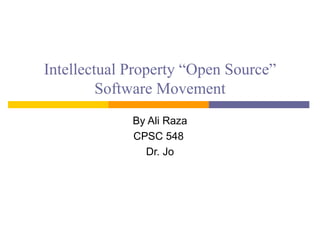
Intellectual Property Open Source Software Movement
- 1. Intellectual Property “Open Source” Software Movement By Ali Raza CPSC 548 Dr. Jo
- 2. Overview Introduction History of Open Source Software Open Source in Today’s World Benefits of open Source Examples of open-source software The GNU Project and Linux Influence of Open-Source Software Legal & Other Risk Associated Critique of the Open-Source Movement
- 3. Introduction Internet Growth during the past few years has been profoundly affected the way software is licensed and distributed. One of the most important changes that has occurred during this period is emergence of so-called open source licensing. Open Source refers to a software program or set of software technologies which are widely available by an individual or group in form of Code form for use Modification Redistribution Under a license agreement having few restrictions
- 4. History Formation of the Software Foundation (FSF) in 1983 FSF released a series of programs in source code from under “GNU” GNU also set stage for even more free software development projects in 1990s The license agreement that accompanied the GNU software – known as the General Public License (“GPL) of “copyleft” license In 1998, a group associated with free software introduced the term “open source”
- 5. Open Source Software in Today’s World No restrictions preventing others from selling and giving away the software Source code must included in the distribution No restriction preventing people from modifying the source code No Restriction regarding how people can use the software Same rights apply to everyone receiving redistributions of the software (copyleft)
- 6. Benefits of Open-Source Software Gives opportunity to improve Rapid evolution of open-source software as a result new versions of programs appears more frequently Eliminates tension between obeying copyright law and helping others Open-Source programs are property of the entire user community.
- 7. Continue…. Shifts focus from manufacturing to service which can result customers getting better support for their software. Access to Source Code Cost
- 8. Example of Open-Source Software Apache BIND PERL, Python, Ruby FireFox GNU compilers from C, C++, Object-C, Fortran, Java, Ada Open Source Frameworks Sturts, Spring, Hibernate, Apache POI, FOP, iText
- 9. Success Story: GNU Project and Linux GNU and Linux are important success stories Richard Stallman begun the GNU Project in 1984 Goal: To Develop a complete Unix-like operating system consisting entirely of open-source software. Most components developed in late 1980s Linux In 1991 Linus Torvalds wrote Unix-like kernel Torvalds combined kernel with GNU components to make an operating system called linux
- 10. Influence of Open-Source Software As a reliable open-source alternative to Unix, Linux is putting pressure on companies selling proprietary versions of Unix. Linux is also putting pressure on Microsoft and Apple, which sell proprietary operating systems for desktop systems.
- 11. Legal & Other Risk Associated Potential liability for intellectual property infringement. Open Source create opportunities for contributors therefore, it introduce infringing code and makes it almost impossible to audit the entire code base Typical license form doesn’t include any intellectual property representation, warranties or indemnities in favor of the licensee.
- 12. Continue…. Open source licenses also do not contain the kind of representations and warranties of quality or fitness for a particular purpose Some open source requires licensees to provide free copies of their derivative works in source code form for other to use, modify and redistribute.
- 13. Critique of the Open-Source Movement Open-source project doesn’t attract a critical mass of developers, as a result quality can be poor Without an ownership, incompatible version may arise Open-source software as a whole trends to have a relatively weak graphical user interface Poor mechanism for stimulating innovation.
- 14. Conclusion Open-Source offers opportunities and disadvantages Opportunities Vast pool of software talent with access to The ability to improve upon Open Source Software The ability to access and utilize software Disadvantages Risk of Utilizing software No warranties Quality may not be up to the mark
- 15. Reference Ethics for the information age 3rd Edition by Michael J Quinn http://www.abanet.org/intelprop/opensource.html http://www.fee.org/PUBLICATIONS/THE-FREEMAN/ http://opensource.mit.edu/papers/vaden.pdf http://www.opensource.org/